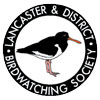LDBWS Field Meeting: A Warm Evening at Birk Bank, nr Quernmore
LDBWS Field Meeting: A Warm Evening at Birk Bank, nr Quernmore. May 30, 6.30PM - 9.30PM Hello All---as it looks like it will be warming up at the weekend you are cordially invited to a LDBWS guided evening bird stroll along the foot of Birk Bank on the edge of Bowland this Sunday. We hope
